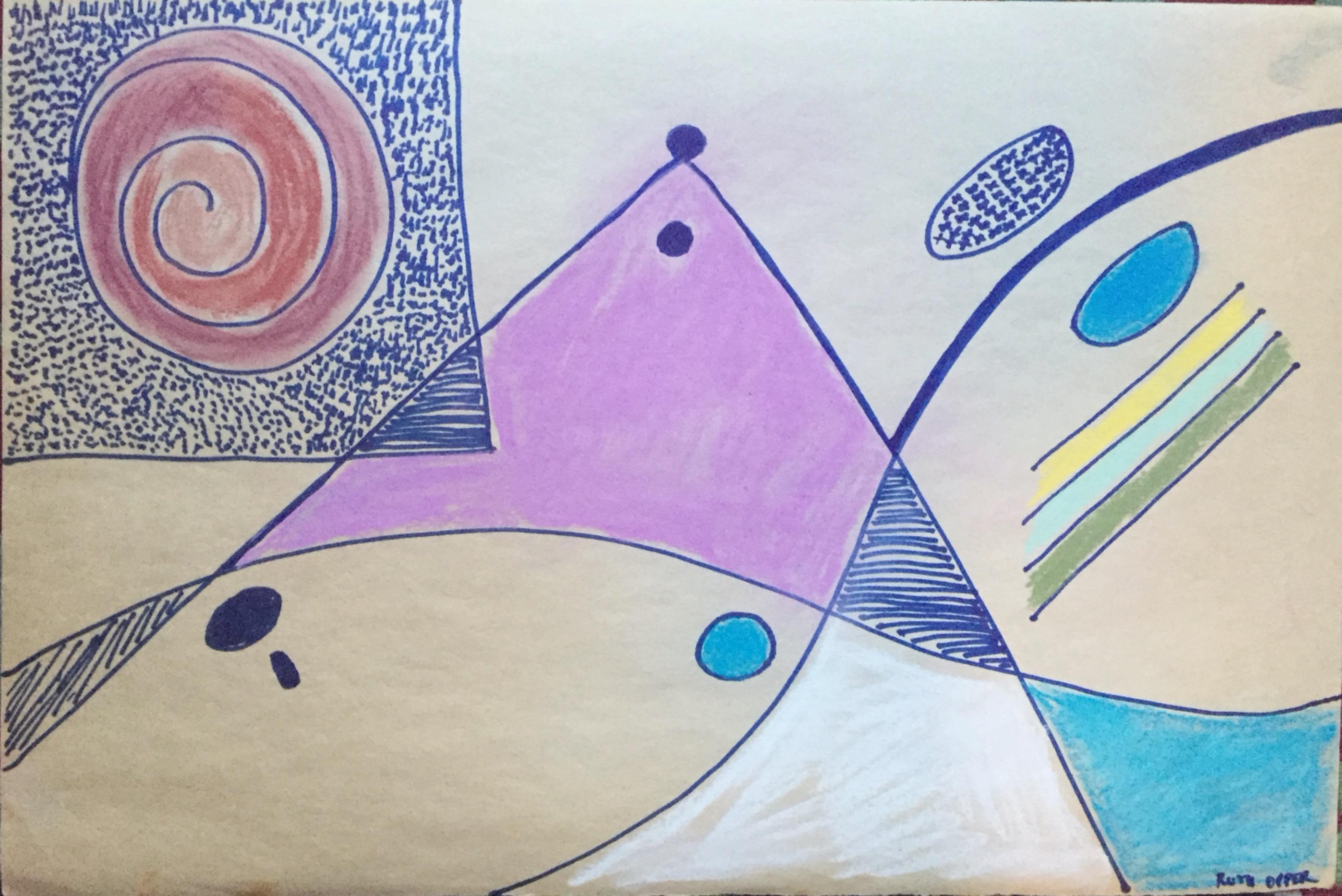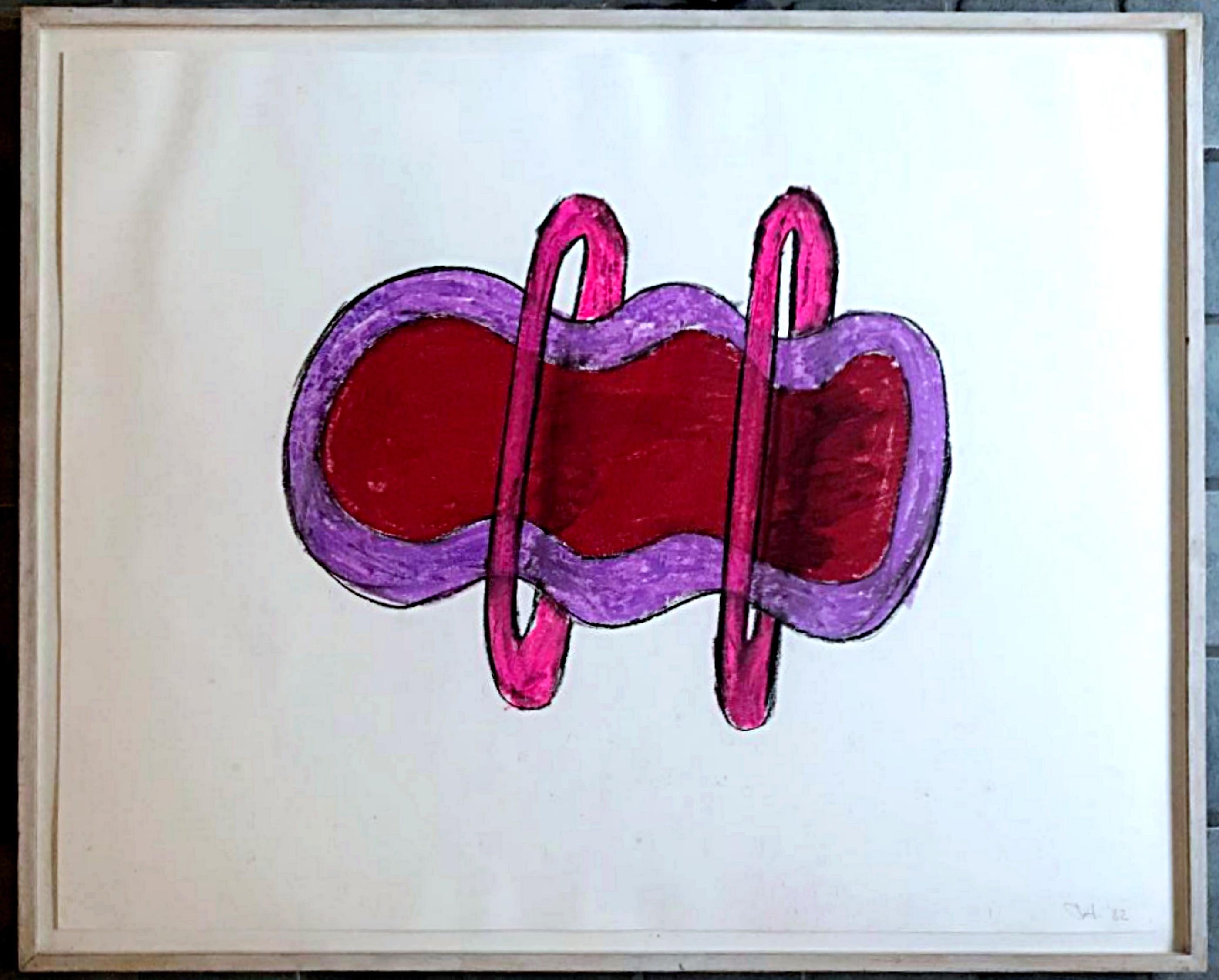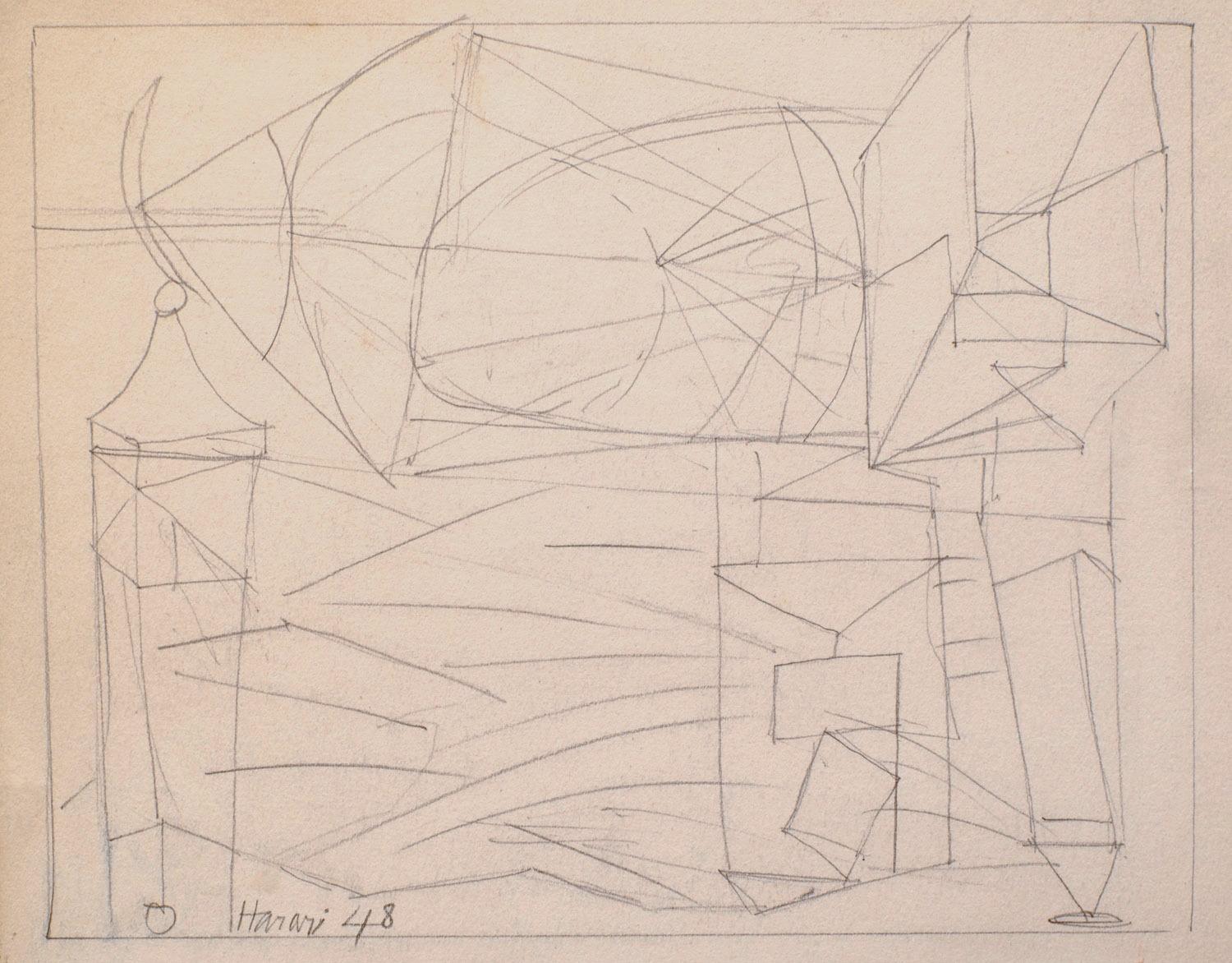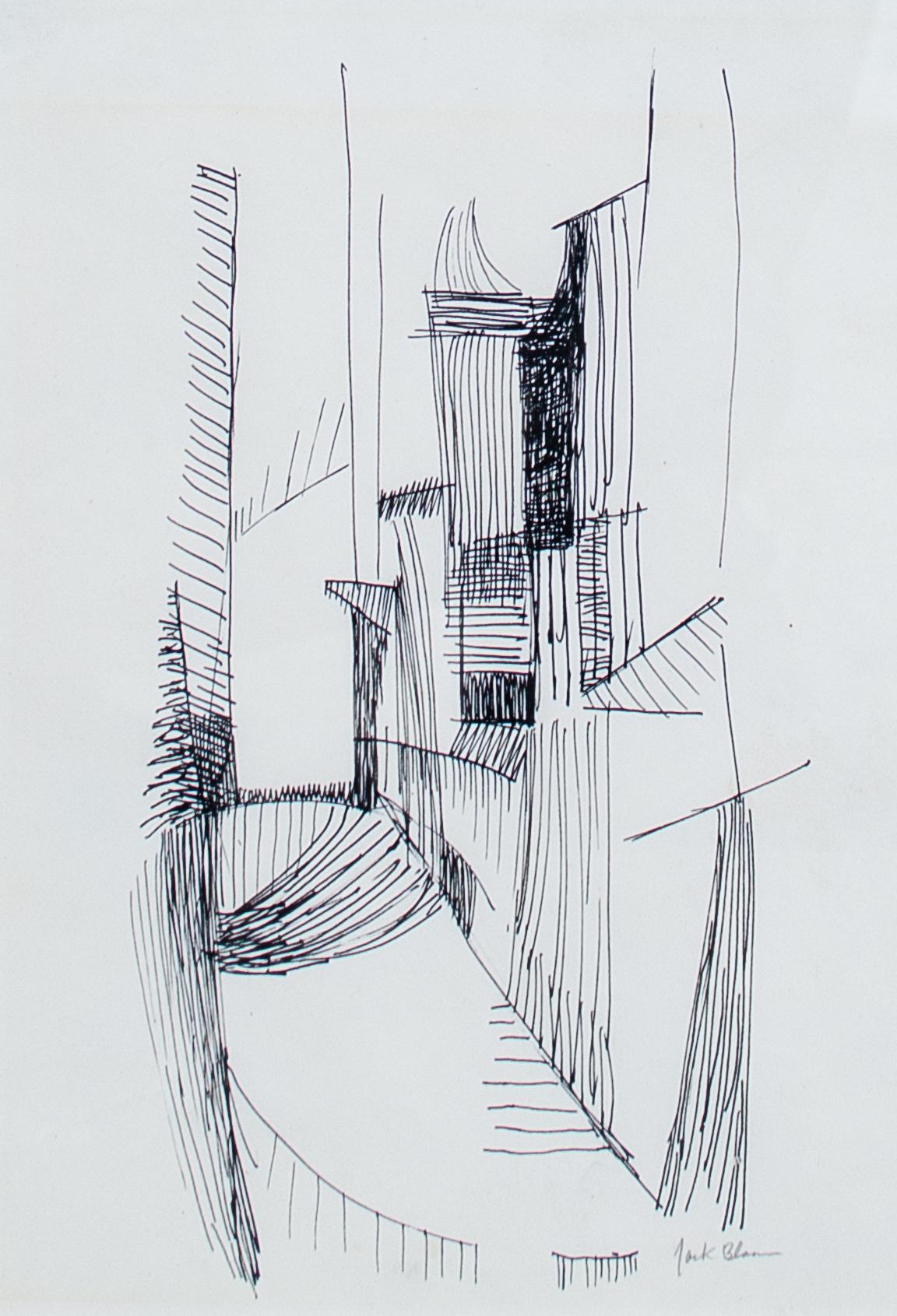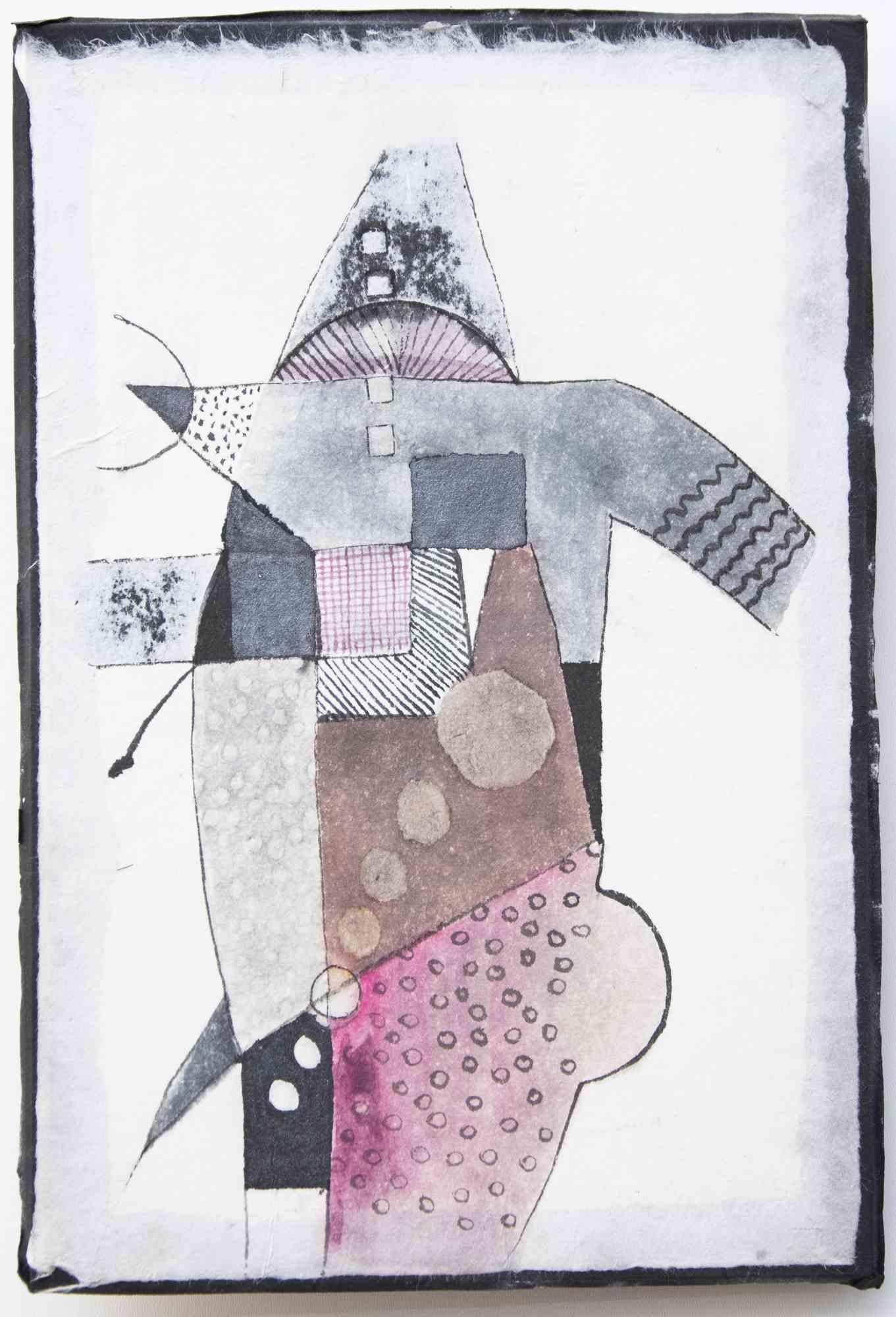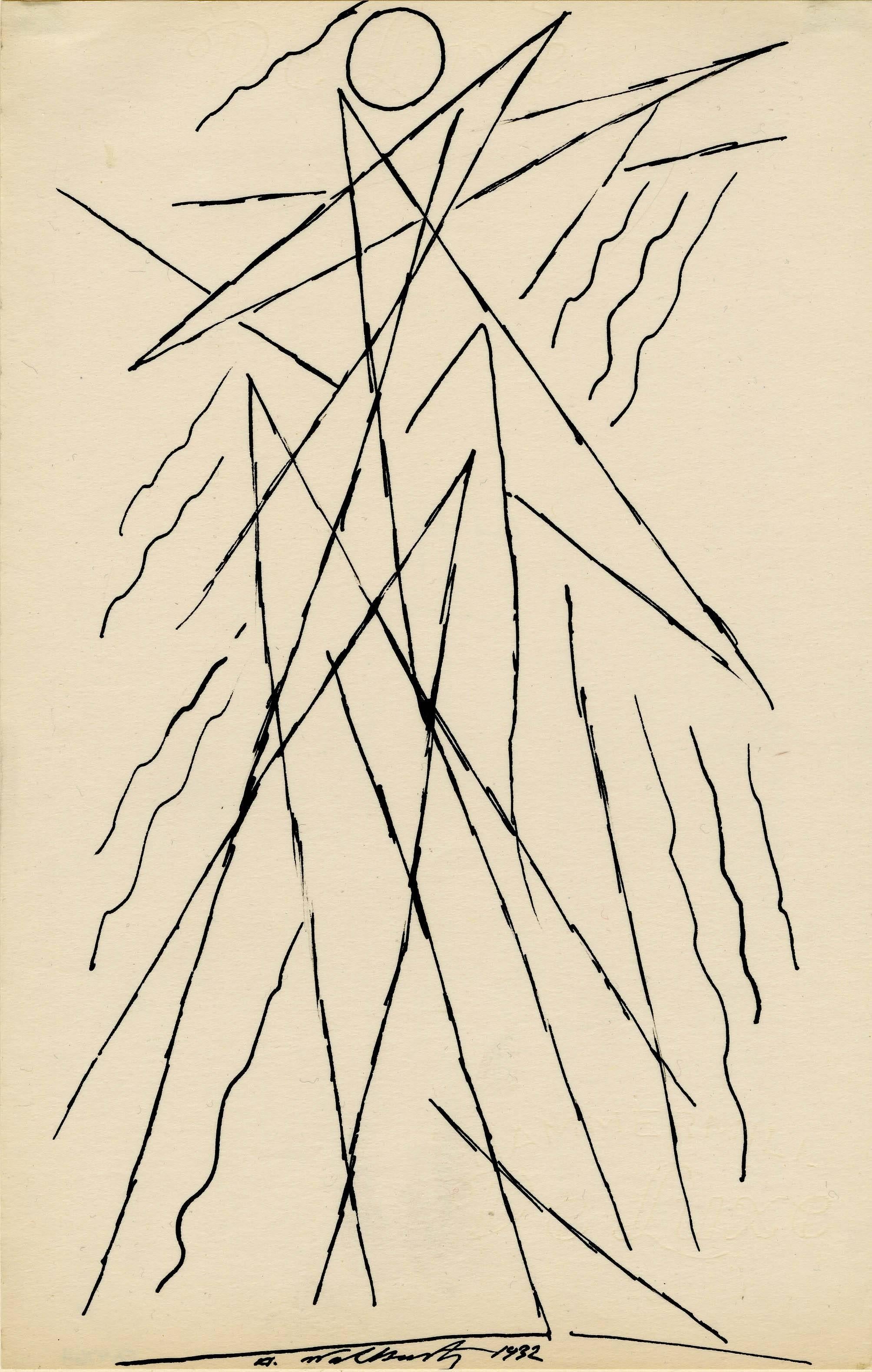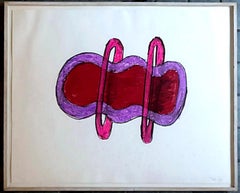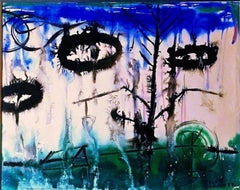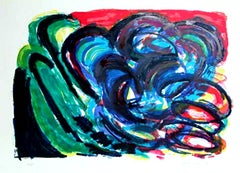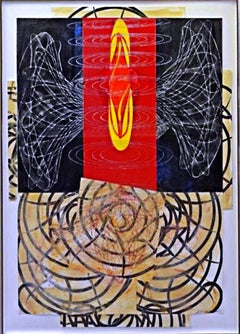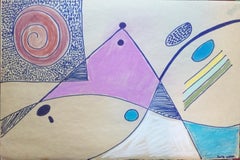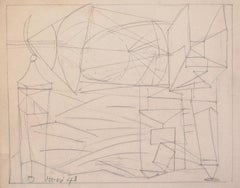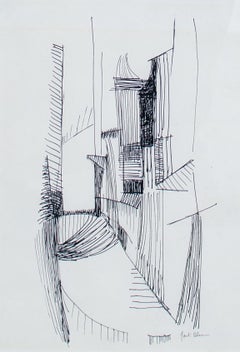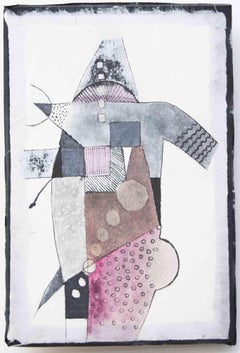Items Similar to Unique SIGNED Abstract Expressionist drawing major WPA artist, Estate issued COA
Want more images or videos?
Request additional images or videos from the seller
1 of 9
William BaziotesUnique SIGNED Abstract Expressionist drawing major WPA artist, Estate issued COA1955
1955
$10,000
£7,753.70
€8,793.83
CA$14,334.57
A$15,589.17
CHF 8,212.72
MX$189,333.42
NOK 103,250.52
SEK 96,789.02
DKK 66,021.54
About the Item
WILLIAM BAZIOTES
Untitled Abstract Expressionist Mid Century Modern ink drawing with Estate COA, ca. 1955
Ink Drawing on Paper
Signed lower right recto. Accompanied by letter of authenticity from Estate.
Unique
Measurements:
Framed:
14.5 inches by 17.5 inches. x .5 inches
Artwork
8.5 x 11 inches
This work is by the American painter William Baziotes. Baziotes graduated from the National Academy of Design in New York. His interest in the surrealism movement can be seen in the lyrical compositions that comprise a large portion of his work. Baziotes, along with David Hare, Robert Motherwell, and Mark Rothko, founded the Subjects of the Artist School. Baziotes was also one of the first New York artists to experiment with the surrealist technique, automatic drawing.
Framed 14.5 inches by 17.5 inches. This work was acquired from the famous Pennypacker auction of the Baziotes Estate, and is accompanied by a letter of authenticity and provenance from the artist's widow Ethel Baziotes.
William Baziotes Biography:
B. 1912, PITTSBURGH; D. 1963, NEW YORK
William Baziotes was born on June 11, 1912, in Pittsburgh, to parents of Greek origin. He grew up in Reading, Pennsylvania, where he worked at the Case Glass company from 1931 to 1933, antiquing glass and running errands. At this time, he took evening sketch classes and met the poet Byron Vazakas, who became a lifelong friend. Vazakas introduced Baziotes to the work of Charles Baudelaire and the Symbolist poets. In 1931, Baziotes saw the Henri Matisse exhibition at the Museum of Modern Art (MoMA), New York, and in 1933 he moved to that city to study painting. From 1933 to 1936, Baziotes attended the National Academy of Design.
In 1936, he exhibited for the first time in a group show at the Municipal Art Gallery, New York, and was employed by the Works Progress Administration (WPA) Federal Art Project as an art teacher at the Queens Museum of Art. Baziotes worked in the WPA's easel division from 1938 to 1941. He met the Surrealist émigrés who came to New York in the late 1930s and early 1940s, and by 1940 knew Jimmy Ernst, Matta (Roberto Sebastián Antonio Matta Echaurren), and Gordon Onslow-Ford. He began to experiment with Surrealist automatism at this time. In 1941, Matta introduced Baziotes to Robert Motherwell, with whom he formed a close friendship. André Masson invited Baziotes to participate with Motherwell, David Hare, and others in First Papers of Surrealism (1942) at the Whitelaw Reid Mansion, New York. In 1943, he took part in two group shows at Peggy Guggenheim's gallery-museum Art of This Century, New York, where his first solo exhibition was held the following year. With Hare, Motherwell, and Mark Rothko, Baziotes founded the Subjects of the Artist school, New York, in 1948. Over the next decade, Baziotes held several teaching positions in New York: at the Brooklyn Museum Art School and New York University (1949–52); People's Art Center, MoMA (1950–52); and Hunter College (1952–62).
In his lifetime, Baziotes's work was included in numerous group exhibitions that helped establish his art alongside that of other abstract painters based in New York, including shows at the Art Institute of Chicago (1947); Metropolitan Museum of Art, New York (1950); MoMA (1951, 1952); São Paulo Biennial (1953–54); Tate Gallery, London (1956); Documenta, Kassel, West Germany (1959); Walker Art Center, Minneapolis (1960); and Guggenheim Museum (1962). Baziotes died in New York on June 6, 1963. A memorial exhibition was presented at the Guggenheim Museum in 1965.
-Courtesy Guggenheim Museum
WILLIAM BAZIOTES BIOGRAPHY
It is the mysterious that I love in my painting. It is the stillness and the silence. I want my picture to take effect very slowly, to obsess and to haunt." (i)
Born in Pittsburgh, William Baziotes grew up in the Greek community of Reading, Pennsylvania. In 1931, he began working for the Case Glass Company—antiquing glass and running errands—while taking evening sketching classes, where he met poet Byron Vazakas, who soon became a close friend. Vazakas exposed him to French symbolist poetry and the work of Charles Baudelaire. That same year, Baziotes saw an exhibition of Henri Matisse’s work at the Museum of Modern Art in New York. In 1933, he moved to New York City and enrolled in classes at the National Academy of Design, where he studied painting with Charles Curran, Ivan Olinsky, Gifford Beal, and Leon Kroll. In 1936, Baziotes left the Academy and participated in his first group exhibition, at the Municipal Art Gallery in New York. He found work with the Works Progress Administration (WPA) as an art teacher at the Queens Museum, and then joined the easel division of the WPA’s Federal Art Project 1938.
In the years leading up to World War II, New York had become a vital gathering center for European surrealist and modernist artists fleeing the rising tide of fascism. Their presence had a profound impact on many of the artists who encountered their work, and Baziotes was no exception. In the late 1930s, he moved away from figural, academic representation, towards increasingly abstract paintings of biomorphic forms. Since surrealism was an entire art ethos—addressing form, content, and just as importantly, an artist’s entire relationship to art—New York was crucial not just for Baziotes’s style but also his approach to creating images. In 1940, Baziotes met Chilean artist Roberto Matta, who in turn introduced him to Robert Motherwell, who became a close friend. In addition to these artists and the European surrealists in exile, Baziotes befriended Jimmy Ernst, Gordon Onslow-Ford, Jackson Pollock, and Lee Krasner. In 1942, Baziotes, his wife (Ethel Copstein Baziotes), Pollock, Krasner, and Motherwell would often meet to play surrealist games and collaborate on poetry. These sessions helped Baziotes open his artwork up to spontaneity and automatism.
In the 1940s, Baziotes gained greater visibility. Marcel Duchamp included Baziotes’s work in his 1942 First Papers of Surrealism exhibition, and the following year, his work appeared in two group shows at Peggy Guggenheim’s Art of This Century Gallery. In 1944, Guggenheim mounted Baziotes’s first solo exhibition, putting him in the company of Motherwell, Pollock, David Hare, and Clyfford Still, all of whom had their inaugural one-man shows at Art of This Century. In his review of the exhibition, Clement Greenberg extolled Baziotes as being “among the six or seven best painters we possess." (ii) Two years later, the Kootz Gallery held his second solo exhibition, and Baziotes joined Kootz’s stable of artists.
Baziotes was a prominent member of the New York School. In addition to his close friendships with abstract expressionist painters and sculptors, he was one of the “Irascibles” made famous in Nina Leen’s 1951 Life photograph, and in 1948, together with Motherwell, Hare, and Mark Rothko, he co-founded the Subjects of the Artist School, an artists group that provided a forum to discuss the issues at stake in contemporary painting. But despite his intimate ties with the world of abstract expressionism, Baziotes’s artwork remained rooted in his own personal take on surrealism: a lyrical, biomorphic abstraction less interested in accessing the unconscious and more concerned with adopting a mysterious and haunted quality, which he imparted through luminous color and eerily foreboding forms.
In the later part of his brief life, Baziotes began to teach extensively at the Brooklyn Museum Art School, New York University, the Museum of Modern Art’s (MoMA) People’s Art Center, and Hunter College. In 1961, Sidney Janis included Baziotes in the Ten American Painters exhibition at his gallery. Two years later, Baziotes died in New York. He has been the subject of several posthumous solo exhibitions including one at the Solomon Guggenheim Museum, New York (1965) and most recently at the Peggy Guggenheim Collection, Venice (2004-2005).
-Courtesy Michael Rosenfeld Gallery
- Creator:William Baziotes (1912-1963, American)
- Creation Year:1955
- Dimensions:Height: 14.5 in (36.83 cm)Width: 17.5 in (44.45 cm)Depth: 0.5 in (1.27 cm)
- Medium:
- Movement & Style:
- Period:
- Condition:Not examined outside of vintage frame but appears fine. (frame is vintage).
- Gallery Location:New York, NY
- Reference Number:1stDibs: LU1745216473262
About the Seller
5.0
Platinum Seller
Premium sellers with a 4.7+ rating and 24-hour response times
Established in 2007
1stDibs seller since 2022
458 sales on 1stDibs
Typical response time: 2 hours
- ShippingRetrieving quote...Shipping from: New York, NY
- Return Policy
Authenticity Guarantee
In the unlikely event there’s an issue with an item’s authenticity, contact us within 1 year for a full refund. DetailsMoney-Back Guarantee
If your item is not as described, is damaged in transit, or does not arrive, contact us within 7 days for a full refund. Details24-Hour Cancellation
You have a 24-hour grace period in which to reconsider your purchase, with no questions asked.Vetted Professional Sellers
Our world-class sellers must adhere to strict standards for service and quality, maintaining the integrity of our listings.Price-Match Guarantee
If you find that a seller listed the same item for a lower price elsewhere, we’ll match it.Trusted Global Delivery
Our best-in-class carrier network provides specialized shipping options worldwide, including custom delivery.More From This Seller
View AllUnique signed abstract painting on paper renowned artist, Albright Knox Gallery
By Jene Highstein
Located in New York, NY
Jene Highstein
Untitled, 1982
Pastel and Chalk on Paper
Hand signed and dated by artist on the front
32 × 40 inches
Frame included
Original hand signed pastel and chalk drawing, with...
Category
1980s Abstract Abstract Drawings and Watercolors
Materials
Paper, Chalk, Pastel, Mixed Media
Untitled Abstract Expressionist painting on paper mid century modern art
By Rolph Scarlett
Located in New York, NY
Rolph Scarlett
Untitled Abstract Expressionist Painting, ca. 1960
Gouache, Ink, Watercolor on Paper . Hand signed, with original Jonas Aarons Gallery label
23 × 18 3/4 inches
Signed ...
Category
Mid-20th Century Abstract Expressionist Abstract Drawings and Watercolors
Materials
Watercolor, Gouache
Description Without Place, abstract expressionist lithograph + silkscreen signed
By Claire Seidl
Located in New York, NY
Claire Seidl
Description Without Place (Hand Signed), 1986
Lithograph and silkscreen.
Hand signed, dated and numbered 17/65 by the artist.
28 × 38 1/2 inches
Unframed
Gorgeous Abstr...
Category
1980s Abstract Abstract Prints
Materials
Screen, Lithograph
In Real Time, unique Signed Abstract Expressionist painting w/provenance, Framed
By Steven Sorman
Located in New York, NY
Steven Sorman
In Real Time, 2003
Acrylic, gouache, gel medium, oil and beeswax collage painting on paper
48 × 34 inches
Signed and dated 2003; The frame also bears the original label...
Category
Early 2000s Abstract Expressionist Abstract Paintings
Materials
Mixed Media, Oil, Acrylic, Gouache, Gel Pen, Graphite
Abstract Expressionist monotype (unique), signed and inscribed with heart Framed
By Robert Natkin
Located in New York, NY
Robert Natkin
monotype (unique) on paper
signed in marker on the front
Pencil signed, and inscribed with heart doodle:
"For Dorothy and Arthur with my Love Natkin"
Provenance: collec...
Category
1970s Abstract Abstract Prints
Materials
Monotype
Unique signed Mid Century Modern Abstract painting by renowned American painter
By Thomas Brownell Eldred
Located in New York, NY
THOMAS BROWNELL ELDRED
Untitled Mid Century Modern Abstraction, 1941
Gouache on paper
Hand signed and dated 1941 on the front
14 3/4 × 21 inches
Unique
Provenance: Acquired from the estate of Thomas Brownell Eldred
Accompanied by Certificate of Guarantee from Alpha 137 Gallery
Unframed
This gorgeously colored gouache painting on thick paper was created at a time when the Guggenheim Museum (Museum of Non-Objective Painting) was collecting Eldred's work, alongside works by Kandinsky and Bauer. Unique works like this by Eldred are very desirable in the marketplace. It typifies the artist's eclectic style, reflecting his involvement with Surrealism and the New York School. It also highlights Eldred’s excellent draftsmanship through the characteristic bright colors and patterns that he developed during his time as a naval wood pattern maker in the merchant marines...
Category
Mid-20th Century Modern Abstract Paintings
Materials
Watercolor, Gouache
You May Also Like
1950s Mid Century Abstract Expressionist Drawing
Located in Arp, TX
From the estate of Jerry and Ruth Opper
Abstract Expressionism Drawing
c.1950s
Ink and Pastel Drawing
18" x 12" Unframed
Unsigned
*Custom framing available ...
Category
Mid-20th Century American Modern Abstract Drawings and Watercolors
Materials
Paper, Pastel, Ink
A 1940s, Mid-Century Modern Abstract Surreal Drawing by Hananiah Harari
By Hananiah Harari
Located in Chicago, IL
A Striking, 1940s Modern Surrealist Abstract Drawing, "Magnetic Prisms", by Notable New York Avant Garde Artist, Hannah Harari (Am. 1912-2000). Graphite on paper, dating from 1948....
Category
Mid-20th Century Abstract Abstract Drawings and Watercolors
Materials
Paper, Graphite
1960s Illegibly signed surrealist ink drawing
Located in New York, NY
Unknown Artist
Untitled, c. 1960s
Ink on paper
Sight size: 10 x 7 in.
Framed: 15 1/4 x 12 1/4 in.
Signed illegibly lower right: Jack Bl...?
Category
1960s Surrealist Abstract Drawings and Watercolors
Materials
Paper, Ink
Abstract composition -Drawing by Unknown -20th Century
Located in Roma, IT
Abstract composition is an original contemporary artwork realized by Anonymous Artist of the late 20th Century.
Mixed colored watercolor on paper glued on a wood panel.
Category
20th Century Contemporary Abstract Drawings and Watercolors
Materials
Watercolor
Abstraction
By Abraham Walkowitz
Located in Fairlawn, OH
Signed and dated in ink lower center
Provenance:
Charlotte Bergman, noted collector and patron of Walkowitz. See photo for additional information.
Category
1930s Modern Abstract Drawings and Watercolors
Materials
Ink, Pen
Abstraction
By Abraham Walkowitz
Located in Fairlawn, OH
Untitled Abstraction
Pen and ink on paper, 1932
Signed and dated in ink lower center
Condition: Excellent
Sheet/Image size: 10 3/8 x 6 1/4 inches
Frame size: 16 1/2 x 12 1/2"
Provena...
Category
1930s Abstract Geometric Abstract Drawings and Watercolors
Materials
Ink, Pen
More Ways To Browse
Framed Drawings
Coa Signed
Abstract Expressionist Ink
Automatic Drawing
Peggy Guggenheim
Wpa Artists
German Early 20th Century Expressionist Painting
Matisse Exhibition
Chilean Artist
Lee Jackson
The Hunter Watercolor Drawing 20th Century
Sidney Janis
Wpa Sign
William Majors
Gj Kimsunken
Helen Kalvak
Homer Guerra On Sale
Hooper Dunbar
